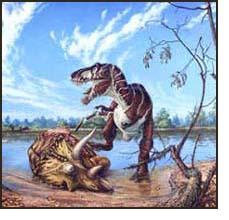
Dinosaurs are the largest animals that have ever lived on land. They roamed the Earth for about 160 million years, but died out 65 million years ago. The first people did not appear on Earth for another 64 million years and have, so far, lived for only a fraction of the time that dinosaurs did.
Scientists knowledge of dinosaurs comes mainly from the study of fossils - hardened remains of plants or animals preserved in rock.
The history of Earth, since it began about 4,500 million years ago, is divided into eras. The age of of the dinosaurs spans most of the Mesozoic, or middle, era. This era is itself divided into three periods - the Triassic (256-208 million years ago), the Jurrasic (208-146 million years ago) and the Crettaceous (146-65 million years ago)(see Geological Time).
Reptiles already existed on Earth before dinosaurs appeared. During the early part of the Triassic period many new kinds were evolving, such as the fast-running cynodont ("dog-toothed") reptiles, which preyed on slow-moving herds of plant-eaters. Most early reptiles held their legs out at an angle from the sides of their bodies, much like today's lizards.
 Eventually these were replaced by archosaurs ("ruling reptiles"). One group had a different body shape and could hold their legs directly below their bodies. This seems to have been the start of the successful body design found in their descendants, the dinosaurs ("terrible lizards").
Eventually these were replaced by archosaurs ("ruling reptiles"). One group had a different body shape and could hold their legs directly below their bodies. This seems to have been the start of the successful body design found in their descendants, the dinosaurs ("terrible lizards").
By the end of the Triassic period, the first true dinosaurs roamed the world. But the dinosaurs' heyday was during the Cretaceous period, when the greatest number and variety were found.
Over 1,000 species of dinosaurs have been recorded so far. These can be divided into two dinstinct groups: herbivores (plant-eaters) and carnivores (meat-eaters).
Of all the dinosaurs that have been discovered, the most popular ones are explored in more detail below and on the next page.